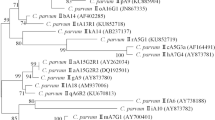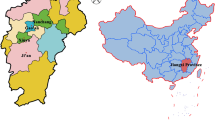Abstract
Cryptosporidium is an important protozoan that causes diarrheal illness in humans and animals. Different species of Cryptosporidium have been reported and it is believed that species characteristics are an important factor to be considered in strategic planning for control. We therefore analyzed oocysts from human and animal isolates of Cryptosporidium by PCR-RFLP to determine strain variation in Isfahan. In total, 642 human fecal samples from children under five years of age, imunocompromised patients, and high-risk persons and 480 randomly selected rectal specimens of cows and calves in Isfahan were examined. Microscopic examination showed that 4.7% (30/642) of human samples and 6.2% (30/480) of animal samples were infected with Cryptosporidium. After identification of the samples infected with the parasite, oocysts were purified and their DNA was extracted. We used PCR-RFLP analysis of a 1750-bp region of the 18S rRNA gene to identify Cryptosporidium species. The human samples were infected with Cryptosporidium parvum II, C. muris, C. wrairi, and a new genotype of Cryptosporidium (GenBank accession no. DQ520951). The cattle samples were identified as C. parvum II, C. muris, C. wrairi, C. serpentis, C. baileyi, and a new genotype of Cryptosporidium (GenBank accession no. DQ520952). We also found a new genotype infecting both human and cattle samples (GenBank accession no. DQ520950). In addition to demonstrating the widespread occurrence of most species of Cryptosporidium, C. parvum, we also observed extensive polymorphism within species. Furthermore, the occurrence of the same species of parasite in both animal and human samples shows the importance of the animal and human cycle.
Similar content being viewed by others
References
Chen X.M., Keithly J.S., Paya C.V., LaRusso N.F. 2002. Current concepts: Cryptosporidiosis. N. Engl. J. Med. 346, 1723–1731.
Fayer R., Morgan U.M., Upton S.J. 2000. Epidemiology of Cryptosporidium: Transmission, detection and identification. Int. J. Parasitol. 30, 1305–1322.
Xiao L., Sulaiman I.M., Ryan U.M., Zhou L., Atwill E.R., Tischler M.L., Zhang X., Fayer R., Lal A.A. 2002. Host adaptation and host-parasite co-evolution in Cryptosporidium: Implications for taxonomy and public health. Int. J. Parasitol. 32, 1773–1785.
Akiyoshi D.E., Dilo J., Pearson C., Chapman S., Tumwine J., Tzipori S. 2003. Characterization of Cryptosporidium meleagridis of human origin passaged through different host species. Infect. Immunol. 71, 1828–1832.
Gatei W., Greensill J., Ashford R.W., Cuevas L.E., Parry C.M., Cunliffe N.A., Beeching N.J., Hart C.A. 2003. Molecular analysis of the 18S rRNA gene of Cryptosporidium parasites from patients with or without human immunodeficiency virus infections living in Kenya, Malawi, Brazil, the United Kingdom, and Vietnam. J. Clin. Microbiol. 41, 1458–1462.
Guyot K., Follet-Dumoulin A., Lelievre E., Sarfati C., Rabodonirina M., Nevez G., Cailliez J.C., Camus D., Dei-Cas E. 2001. Molecular characterization of Cryptosporidium isolates obtained from humans in France. J. Clin. Microbiol. 39, 3472–3480.
Xiao L., Bern C., Limor J., Sulaiman I., Roberts J., Checkley W., Cabrera L., Gilman R.H., Lal A.A. 2001. Identification of 5 types of Cryptosporidium parasites in children in Lima, Peru. J. Infect. Dis. 183, 492–497.
Morgan U.M., Fall A., Ward L.A., Hijjawi N., Sulaiman I., Fayer R., Thompson R.C., Olson M., Lal A., Xiao L. 2002. Cryptosporidium hominis n. sp. (Apicomplexa: Cryptosporidiidae) from Homo sapiens. J. Eukaryot. Microbiol. 49, 433–440.
Morgan U.M., Xiao L., Fayer R., Lal A.A., Thompson R.C. 1999. Variation in Cryptosporidium: Towards a taxonomic revision of the genus. Int. J. Parasitol. 29, 1733–1751.
Xiao L., Morgan U.M., Limor J., Escalante A., Arrowood M., Shulaw W., Thompson R.C., Fayer R., Lal A.A. 1999. Genetic diversity within Cryptosporidium parvum and related Cryptosporidium species. Appl. Environ. Microbiol. 65, 3386–3391.
Xiao L., Singh A., Limor J., Graczyk T.K., Gradus S., Lal A.A. 2001. Molecular characterization of Cryptosporidium oocysts in samples of raw surface water and wastewater. Appl. Environ. Microbiol. 67, 1097–1101.
Straub T.M., Daly D.S., Wunshel S., Rochelle P.A., DeLeon R., Chandler D.P. 2002. Genotyping Cryptosporidium parvum with an hsp70 single-nucleotide polymorphism microarray Appl. Environ. Microbiol. 68, 1817–1826.
Sulaiman I.M., Lal A.A., Xiao L. 2002. Molecular phylogeny and evolutionary relationships of Cryptosporidium parasites at the actin locus. J. Parasitol. 88, 388–394.
Arrowood M.J., Sterling C.R. 1987. Isolation of Cryptosporidium oocysts and sporozoites using discontinuous sucrose and isopycnic percoll gradients. J. Parasitol. 73, 314–319.
Henriksen S.A., Pohlenz J.F.L. 1981. Staining Cryptosporidia by a modified Ziehl-Neelson technique. Acta. Vet. Scand. 22, 594–596.
Boom R., Sol C.J.A., Salimans M.M.M., Jansen C.L., Wertheim-Van Dillen P.M.E., van der Noordaa J. 1990. Rapid and simple method for purification of nucleic acids. J. Clin. Microbiol. 28, 495–503.
Kimbell L.M., Miller D.L., Chavwz W., Altman N. 1999. Molecular analysis of the 18S rRNA gene of Cryptosporidium serpentis in a wild-caught corn snake (Elaphe guttata guttata) and a five species restriction fragment length polymorphism based assay that can additionally discern C. parvum from C. wrairi. Appl. Environ. Microbiol. 65, 5345–5349.
Leng X., Mosier D.A., Oberst R.D. 1996. Differentiation of Cryptosporidium parvum, C. muris and C. baileyi by PCR-RFLP analysis of the 18S rRNA gene. Vet. Parasitol. 62, 1–7.
Katsumata T., Hosea D., Ranuh I.G., Uga S., Yanagi T., Kohno S. 2000. Short report: Possible Cryptosporidium muris infection in humans. Am. J. Trop. Med. Hyg. 62, 70–72.
Pieniazek N.J., Borny-Linares F.J., Slemenda S.B., Silva A.J.D., Moura I.N.S., Arrowood M.J., Ditrich O., Addiss D.G. 1999. New Cryptosporidium genotypes in HIV-infected person. Emerg. Infect. Dis. 3, 4444–4449.
Santin M., Trout J.M., Xiao L., Zhou L., Greiner E., Fayer R. 2004. Prevalence and age-related variation of Cryptosporidium species genotypes in diary calves. Vet. Parasitol. 122, 103–117.
Perz J.F., Le Blancq S.M. 2001. Cryptosporidium parvum infection involving novel genotypes in wildlife from lower New York State. Appl. Environ. Microbiol. 67, 1154–1162.
Hunter P.R., Syed Q. 2000. Report of an Outbreak of Cryptosporidiosis in the Northwest Region, April and May 1999. Liverpool: CDSC-NW.
Dumoulin A., Guyot K., Leliever E., Dei-Cas E., Cailliez J.C. 2000. Cryptosporidium and wildlife: A risk for humans? J. Parasitol. 7, 167–172.
Guyot K., Gireaudot-Liepmann M.F., Cabon A., Riveau-Ricard I., Lange M., Delattre J.M., Del-Cas E. 2000. Influence of US EPA 1622 method successive steps on the viability of Cryptosporidium oocysts. Water Sci. Technol. 41, 189–196.
Meinhardt P.L., Casemore D.P., Miller K.B. 1996. Epidemiologic aspects of human cryptosporidiosis and the role of waterborne transmission. Epidemiol. Rev. 18, 118–136.
Author information
Authors and Affiliations
Corresponding author
Additional information
Published in Russian in Molekulyarnaya Biologiya, 2007, Vol. 41, No. 5, pp. 934–939.
The article was translated by the authors.
Rights and permissions
About this article
Cite this article
Azami, M., Moghaddam, D.D., Salehi, R. et al. The identification of Cryptosporidium species in Isfahan, Iran by PCR-RFLP analysis of the 18S rRNA gene. Mol Biol 41, 851–856 (2007). https://doi.org/10.1134/S0026893307050196
Issue Date:
DOI: https://doi.org/10.1134/S0026893307050196




